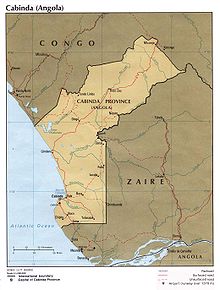Frente para a Libertação do Enclave de Cabinda
The Frente para a Libertação do Enclave de Cabinda ( FLEC ; in German "Front for the Liberation of the Cabinda Enclave") is a separatist movement in the Cabinda exclave belonging to Angola .
The FLEC as a movement for an independent Cabinda
Between its founding year 1963 and 1975, the year Angola was liberated from the colonial power Portugal , the FLEC fought in Cabinda against the colonial army independently of the liberation movements in the rest of the, often larger, Angola. When in 1974 Cabinda was recognized by the Organization for African Unity (OAU) as the 39th state in Africa and its decolonization demanded, the goal seemed near. In 1975 the FLEC set up a transitional government led by Enriquez Tiago , which declared Cabinda's independence from Portugal on August 1, 1975. From November 1975 to January 4, 1976, however, soldiers of the leading Angolan independence movement, Movimento Popular de Libertação de Angola , marched(MPLA) into the Cabinda exclave. They were supported by Cuban troops and quickly gained the upper hand in the region.
In the 1980s, the FLEC received support from UNITA , which, with the support of the apartheid regime of South Africa, fought against the Angolan government controlled by the (then) Marxist MPLA. In doing so, however, she had sided with the loser in the Angolan civil war . When the USA ended its support for UNITA in the 1990s and the apartheid regime in South Africa had to hand over power to the ANC, the FLEC's fight was finally lost militarily.
In April 1996 a ceasefire agreement was signed between the FLEC-Renovada and the Angolan government. Other groups later joined this treaty.
The "Republic of Cabinda" proclaimed by the FLEC is a member of the UNPO , in which "unrepresented" peoples have come together.
On January 8, 2010, the FLEC attacked the Togolese national soccer team , killing three members of the delegation and injuring other delegates.
This was followed by increased military and political repression by the Angolan government. Various FLEC leaders were arrested. This has not carried out any armed actions since 2010. The general elections that were held in Angola in 2012 and in which the MPLA won a total of 70% of the votes became the yardstick. In Cabinda, 40% went to the opposition, especially UNITA and CASA, but around 60% went to the MPLA.
Organizational history of the FLEC
The history of the FLEC as an organization is one of union and division.
The FLEC was created in 1963 by the union of three nationalist movements:
- MLEC - Movemento de Liberaçao do Enclave de Cabinda (Movement for the Liberation of the Cabinda Enclave)
- CAUNC - Comite d'acçao do Union Nacional Cabindesa (Action Committee of the National Union Cabindas)
- ALLIAMA - Aliança Nacional do El Mayombe ( El Mayombe National Alliance; Mayombe is a mountain in eastern Cabinda)
The flag of the MLEC was yellow with a seal in the center depicting Mayombe Mountain.
The leader of the united movement was Luiz Ranque Franque , who refused to join other Angolan independence movements that fought for independence from Portugal in the rest of Angola. The FLEC adopted a flag with horizontal red, yellow and blue stripes - one color for each of the three groups. A new emblem (a white star and a green triangle in a ring) has been added in the center.
After the conquest of Cabinda by the MPLA troops from Angola in 1975, the FLEC split again into three factions:
- FLEC-Ranque Franque
- FLEC-N'Zita, led by Henrique Tiago N'Zita
- FLEC-Lubota, led by Francisco Xavier Lubota
In November 1977 another faction was formed, the
- Military command for the liberation of Cabinda
In June 1979 a fifth movement emerged, the
- Popular Movement for the Liberation of Cabinda (Movimento Popular de Libertação de Cabinda).
And in the 1990s two additional factions were formed:
- UNLC - the National Association for the Liberation of Cabinda (União Nacional de Libertação de Cabinda), led by Lumingu Luis Gimby
- CCC - the Cabindas Communist Committee (Comité Communista de Cabinda), headed by Kaya Mohamed Yay
The original FLEC was re-established in the 1990s and two factions were formed:
- The FLEC-Renovada, whose flag was white with a central stripe divided into three colors - green, yellow and black - with a red ring in the center of the flag
- The FLEC Armed Forces of Cabinda (Forças Armadas do Cabinda - FLEC-FAC) which used the original red, blue and yellow flag with the emblem
In 1996, another group formed among Cabinda exiles in the Netherlands , the Frente de Libertação do Estado de Cabinda (Liberation Front for the Cabinda State). This group adopted a blue, yellow, and black flag with a badge from the Silambuco monument in Cabinda in the center.
swell
- ^ Jeune Afrique Economie May 4, 1998.
- ↑ Cabinda at UNPO
- ^ Angola • After attack: Togo cancels Africa Cup participation. Der Tagesspiegel , January 9, 2010, accessed on December 21, 2010 .
- ^ After the attack in Angola: Togo plans to leave on Sunday, Zeit.de of January 9, 2010 ( Memento of February 14, 2010 in the Internet Archive )

